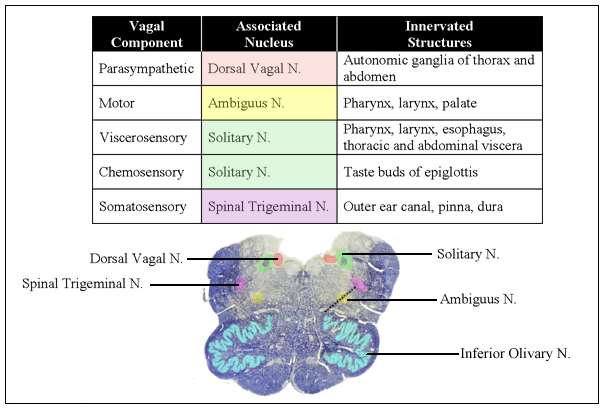Lab 9 (ƒ 10) - Cranial Nerve Nuclei and Brain Stem Circulation
Cranial Nerve X - Vagus Nerve
Components of the Vagus Nerve include:
- Preganglionic parasympathetic fibers from the dorsal vagal motor nucleus terminate in parasympathetic ganglia located near the thoracic and abdominal viscera.
- Motor fibers from the nucleus ambiguus innervate the muscles of the palate, pharynx and larynx
- Viscerosensory fibers innervate the pharynx, larynx, trachea, esophagus, and thoracic and abdominal viscera and end in the nucleus solitarius.
- Chemosensory fibers innervate taste buds in the epiglottis and end in the rostral (gustatory) component of the nucleus solitarius.
- Somatosensory fibers innervate the outer ear canal, part of the ear (pinna), and dura and end in the spinal trigeminal nucleus.
 The location of these nuclei is shown in the figure. The ambiguus nucleus, as its name suggests, is somewhat ambiguous in location. To find it look at the midpoint of an imaginary line connecting the spinal trigeminal nucleus with the posterior part of the inferior olive.
The location of these nuclei is shown in the figure. The ambiguus nucleus, as its name suggests, is somewhat ambiguous in location. To find it look at the midpoint of an imaginary line connecting the spinal trigeminal nucleus with the posterior part of the inferior olive.
The dorsal vagal motor neurons are visceral efferents and their axons are distributed (as preganglionic parasympathetic fibers) to autonomic ganglion cells located in or near the viscera of the thorax and abdomen. The descending colon and pelvic viscera receive comparable innervation from the sacral parasympathetic fibers. The autonomic ganglia of the thorax and abdomen innervate involuntary musculature, the pancreas, liver, and glands. Activation of the dorsal vagal nucleus inhibits heart rate and suprarenal secretion and stimulates gastrointestinal peristalsis, gastric and hepatic glands and the pancreas.
Bilateral destruction of the dorsal vagal motor neurons will produce paralysis and atonia (loss of muscle tone) of the esophagus and stomach which result in pain and vomiting. The loss of inhibitory influences, which results from destruction of these neurons, will cause the heart rate to become rapid and irregular. The dorsal vagal motor nucleus receives short connecting fibers from the nucleus solitarius and from interneurons. These provide input from afferents innervating the cardiovascular, pulmonary and digestive systems which initiate automatic responses affecting blood pressure, blood gas levels, etc.
The cortical input to the dorsal vagal motor nucleus is bilateral and indirect. Bilateral damage to corticobulbar fibers result in vasomotor changes and may produce changes in secretory and motor functions of the stomach.
The three sensory pathways associated with the vagus nerve are:
- Viscerosensory (throat)
- Gustatory (epiglottis)
- Somatosensory (external ear and dura)
Because vagus somatic motor fibers innervate the pharynx and larynx which form the efferent limb of the cough reflex arc, section of the vagus nerve results in the loss of the cough reflex.
Vagal motor fibers also innervate the heart, thus section of the vagus nerve would remove the efferent limb of the reflex arc, and result in the loss of the carotid sinus reflex. This reflex normally regulates arterial blood pressure.
Clinical Testing of Dorsal Vagal component of CN-X
- Oculocardiac Reflex: Press over orbit to produce cardiac slowing
- Carotid Sinus Reflex: Press on carotid sinus to produce cardiac slowing
